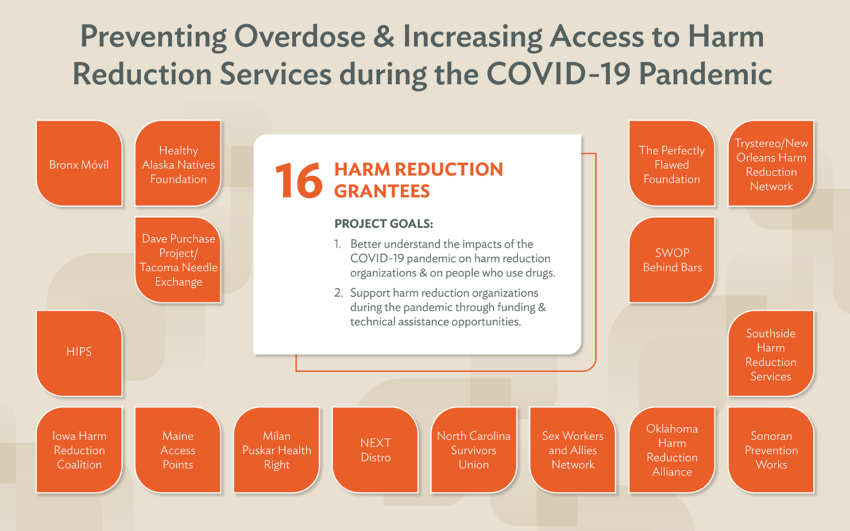This guide aims to support harm reduction organizations operating in virtual environments and summarizes some of the strategies that harm reduction organizations have developed and found to be effective at maintaining connection while doing harm reduction work virtually.
Maintaining Connection: Strategies to Manage a Virtual Harm Reduction WorkplaceGrounded in the principle of “meeting people where they’re at, but not leaving them there,” harm reduction practices aim to reduce the harms associated with substance use by providing non-judgmental services and supports to people who use drugs. Strongly supported by evidence, a wide-range of harm reduction practices exist that reduce risk of overdose, overdose death, infectious disease transmission, and other substance use-related harms. Harm reduction services include syringe access, overdose education and naloxone distribution, fentanyl test strips, agonist-based medications for opioid use disorder, safer use supplies, wound care, housing support, and social supports, among many others. For decades, harm reduction organizations have provided life-saving essential services to people who use drugs and their communities.
In 2020, the National Council for Mental Wellbeing, with support from the Centers for Disease Control and Prevention (CDC), launched Preventing Overdose and Increasing Access to Harm Reduction Services during the COVID-19 Pandemic. This initiative provided $500,000 in rapid response funding grants to 16 harm reduction organizations across the nation to support harm reduction services throughout the pandemic. In addition to funding support, the National Council is working in partnership with CDC to develop training and technical assistance tools to increase adoption of effective harm reduction practices nationwide.

To better support organizations that provide care to PWUD, the National Council, with support from the CDC, developed this resource guide organized by five strategies to address implementation challenges and leverage these advances to improve the health and wellness of PWUD.
Supporting Telehealth and Technology-assisted Services for People Who Use Drugs: A Resource GuideTo better understand the impact of the COVID-19 pandemic on harm reduction organizations and people who use drugs, the National Council for Mental Wellbeing, with support from the Centers for Disease Control and Prevention (CDC), conducted an environmental scan consisting of a literature review and 21 key informant interviews with staff from harm reduction organizations in the U.S.
COVID-19 Pandemic Impact on Harm Reduction Services: An Environmental ScanTo better understand the technical assistance needs among mental health and SUD treatment providers related to adopting harm reduction services for PWUD, the National Council, with support from the National Association of County and City Health Officials, conducted a mixed-methods stakeholder analysis between February and July 2022.
Harm Reduction Stakeholder Analysis: A Summary of FindingsHarm Reduction across the National Council
Check out our harm reduction work across our organization below. For more information contact Caroline Davidson at CarolineD@TheNationalCouncil.org.
Blogs
- Harm Reduction is About Hope and Saving People’s Lives
- Harm Reduction: Essential Now and Always
- Understanding Harm Reduction: Part 1 – National Council Distributes Grants to 16 Harm Reduction Organizations to Address Nation’s Overdose Crisis
- Understanding Harm Reduction: Part 2 – Harm Reduction Advocates Step Up to Help People in Crisis
- Understanding Harm Reduction: Part 3 – Harm Reduction Advocates Face Hurdles and Hope
Resources
- Providing Harm Reduction Services in Native Communities: Key Considerations from a Facilitated Discussion
- Supporting Telehealth and Technology-assisted Services for People Who Use Drugs: A Resource Guide
- COVID-19 Pandemic Impact on Harm Reduction Services: An Environmental Scan
- Harm Reduction Stakeholder Analysis: A Summary of Findings
- Maintaining Connection: Strategies to Manage a Virtual Harm Reduction Workplace
- Findings Report: Data Support Needs from Harm Reduction Organizations
Webinars
- Integrating Harm Reduction into the Substance Use Disorder Care Continuum
- Community-driven Harm Reduction Innovation and Adaptation
- Leveraging Innovation & Technology to Care for People Who Use Drugs: Strategies from the Field
- Harm Reduction during the COVID-19 Pandemic: Strategies from the Field
- Wellness Strategies for Harm Reduction Providers During the COVID-19 Pandemic
Wellness Webinar Series
Expanding upon the peer-run learning collaborative hosted with grantees in the previous year on wellness and burnout prevention, this national webinar series will discuss this topic across 3 sessions. While there are a wealth of wellness and burnout prevention webinars in the field, the needs of the harm reduction community are unique due to the nature of the work, such as preventing re-traumatization and managing grief related to overdose deaths. Webinar presenters will include National Council clinical experts, external subject matter experts and grantees that have implemented innovative strategies to support wellness and burnout prevention.
- Part 1: Establishing Professional Boundaries in the Virtual Harm Reduction Workplace
- Part 2: Coping with Grief and Loss in the Harm Reduction Workplace
- Part 3: Supporting the Emotional and Mental Health Needs of Harm Reduction Staff
Additional Resources:
- Maintaining Connection: Strategies to Manage a Virtual Harm Reduction Workplace
- Fostering Resilience and Recovery: A Change Package
- 16 Simple Ways to Relieve Stress
- Coronavirus Anxiety: Coping with Stress, Fear, and Worry
- Tips and Strategies to Manage Anxiety and Stress
- You’re Wired for Anxiety. And You’re Wired to Handle It
- Compassion Resilience Toolkit
- The Neurosequential Network’s Stress & Trauma Series
- Self-care Wheel
- Wellness Time Policy
This publication was made possible by grant number 6 NU38OT000318-02-02 from the Centers for Disease Control and Prevention (CDC) of the U.S. Department of Health and Human Services (HHS) as part of a financial assistance award totaling $750,000 with 100% funded by CDC/HHS. The contents are those of the author(s) and do not necessarily represent the official views of, nor an endorsement by, CDC/HHS or the U.S. Government.
Subscribe for Updates
Receive the latest updates, news and resources related to harm reduction and overdose prevention by subscribing to the National Council’s Overdose Prevention and Harm Reduction Newsletter.
